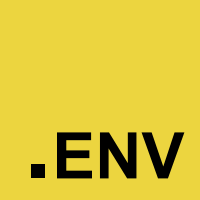dotenv
Dotenv loads environment variables from .env into ENV (process.env).
"Storing configuration in the environment is one of the tenets of a twelve-factor app. Anything that is likely to change between deployment environments–such as resource handles for databases or credentials for external services–should be extracted from the code into environment variables.
But it is not always practical to set environment variables on development machines or continuous integration servers where multiple projects are run. Dotenv loads variables from a
.envfile into ENV when the environment is bootstrapped."
Install
npm install dotenv --saveUsage
As early as possible in your application, require and load dotenv.
require('dotenv').load();Create a .env file in the root directory of your project. Add
environment-specific variables on new lines in the form of NAME=VALUE.
For example:
DB_HOST=localhost
DB_USER=root
DB_PASS=s1mpl3
That's it.
process.env now has the keys and values you defined in your .env file.
db.connect({
host: process.env.DB_HOST,
username: process.env.DB_USER,
password: process.env.DB_PASS
});Preload
If you are using iojs-v1.6.0 or later, you can use the --require (-r) command line option to preload dotenv. By doing this, you do not need to require and load dotenv in your application code.
$ node -r dotenv/config your_script.jsThe configuration options below are supported as command line arguments in the format dotenv_config_<option>=value
$ node -r dotenv/config your_script.js dotenv_config_path=/custom/path/to/your/env/varsConfig
config will read your .env file, parse the contents, and assign it to
process.env - just like load does. You can additionally, pass options to
config.
Note: config and load are synonyms. You can pass options to either.
Options
Silent
Default: false
Dotenv outputs a warning to your console if missing a .env file. Suppress
this warning using silent.
require('dotenv').config({silent: true});Path
Default: .env
You can specify a custom path if your file containing environment variables is named or located differently.
require('dotenv').config({path: '/custom/path/to/your/env/vars'});Encoding
Default: utf8
You may specify the encoding of your file containing environment variables using this option.
require('dotenv').config({encoding: 'base64'});Parse
The engine which parses the contents of your file containing environment variables is available to use. It accepts a String or Buffer and will return an Object with the parsed keys and values.
var dotenv = require('dotenv');
var buf = new Buffer('BASIC=basic');
var config = dotenv.parse(buf); // will return an object
console.log(typeof config, config) // object { BASIC : 'basic' }Rules
The parsing engine currently supports the following rules:
BASIC=basicbecomes{BASIC: 'basic'}- empty lines are skipped
- lines beginning with
#are treated as comments - empty values become empty strings (
EMPTY=becomes{EMPTY: ''}) - single and double quoted values are escaped (
SINGLE_QUOTE='quoted'becomes{SINGLE_QUOTE: "quoted"}) - new lines are expanded if in double quotes (
MULTILINE="new\nline"becomes
{MULTILINE: 'new
line'}
- inner quotes are maintained (think JSON) (
JSON={"foo": "bar"}becomes{JSON:"{\"foo\": \"bar\"}")
Expanding Variables
Basic variable expansion is supported.
BASIC=basic
TEST=$BASIC
Parsing that would result in {BASIC: 'basic', TEST: 'basic'}. You can escape
variables by quoting or beginning with \ (e.g. TEST=\$BASIC). If the
variable is not found in the file, process.env is checked. Missing variables
result in an empty string.
BASIC=basic
TEST=$TEST
DNE=$DNE
TEST=example node -e 'require("dotenv").config();'process.env.BASICwould equalbasicprocess.env.TESTwould equalexampleprocess.env.DNEwould equal""
FAQ
Should I commit my .env file?
No. We strongly recommend against committing your .env file to version
control. It should only include environment-specific values such as database
passwords or API keys. Your production database should have a different
password than your development database.
Should I have multiple .env files?
No. We strongly recommend against having a "main" .env file and an "environment" .env file like .env.test. Your config should vary between deploys, and you should not be sharing values between environments.
In a twelve-factor app, env vars are granular controls, each fully orthogonal to other env vars. They are never grouped together as “environments”, but instead are independently managed for each deploy. This is a model that scales up smoothly as the app naturally expands into more deploys over its lifetime.
Contributing
Who's using dotenv
Here's just a few of many repositories using dotenv:




